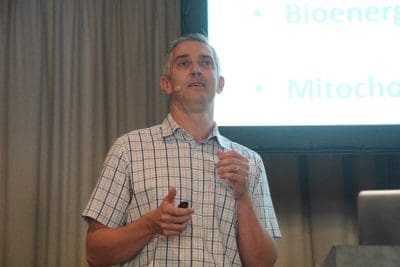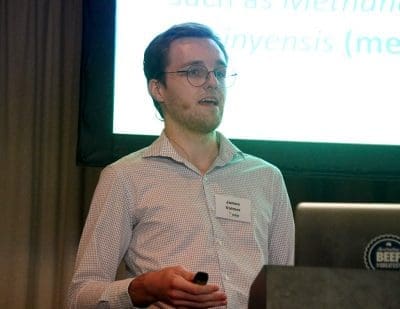
UQ researchers Drs Simon Quigley (right) and Nick Hudson (left), with PhD student James Volmer, during yesterday’s MLA R&D breakfast in Brisbane
START talking about industry R&D investments at a cellular or molecular level, and it’s more than likely that most beef producers’ eyes will ‘glaze over.’
Such research seems far-removed from the everyday cycles and challenges that cattle producers face in the paddock, but an industry gathering yesterday was shown the potential for some profound advances to be made in industry productivity and efficiency through greater knowledge at this more ‘speculative, blue-sky’ level of research.
Consider these possibilities for a moment:
- Determining the feed efficiency potential of a beast from a simple tissue or blood sample
- Moderating methane production in the rumen by manipulating or managing rumen microflora
- Dramatically enhancing feed intake in cattle on nutrient-deficient pastures
All have the potential to deliver considerable productivity advantages to industry, if this current phase of ‘basic’ research delivers the right outcomes.
Introducing the topics at an MLA’s beef industry R&D showcase breakfast yesterday was Prof Wayne Brydon, head of the foundation chair of animal science at University of Queensland.
“We’re at an interesting stage, because of breakthroughs in science – especially things like digital technology – and at the molecular level it is allowing us to see in much greater detail how an animal works, and how it may be manipulated to increase productivity,” Prof Bryden said.
“At the same time that can be done in a way that is going to improve the welfare of the animal,” he said.
“With all of those things coming together, we are at the cusp of some great moves forward in the livestock industries. Ultimately their application, at the paddock level, is going to increase sustainability.”
The thing that would bring those digital and molecular technologies together was big data, Prof Brydon said.
“If I had been talking to a producer group about ‘AI’ only five or ten years ago, they would have been talking about artificial breeding. Today, ‘AI’ can refer to artificial intelligence, which is one of the drivers of these new technologies.”
Here’s a quick snapshot of some of the emerging research taking place, at molecular level:
Opportunities to lift feed intake
UQ researcher Dr Simon Quigley outlined his producer levy-funded work, focused on feed intake regulation in cattle, especially those on lower quality diets.
By and large, as energy intake increases, there is an increase in an animal’s liveweight gain, and hence productivity, he said. However in northern production systems, there is often suppression in feed intake during the dry season (on Mitchell grass, for example), when there is significantly lower intake compared to animals consuming a high-protein hay.

Dr Simon Quigley
Similarly in the wet season where there was potential for phosphorous deficiency, feed intake could be suppressed on a low-phosphorous intake diet.
“We’re talking about a 30 to 50 percent reduction in feed intake due to a nutrient deficiency, resulting in low liveweight gain (or in fact, loss) during those periods,” Prof Quigley said.
What Dr Quigley’s research team was focusing on in this ‘blue-sky’ research space was how these ‘signals’ coming from the environment, the peripheral tissues, the feed itself and the absorbed nutrient, were integrated in the animal’s brain to suppress its appetite – effectively, whether the animal eats, or slows eating, based on the available feed resource.
The work focuses on a small part of the animal’s brain called the hypothalamus, which has an important role in regulating body metabolism, and signaling for the secretion of hormones for other purposes. It is also a key regulator of feed intake in sheep and cattle.
“We know that we can balance diets with supplements to increase pasture intake,” Prof Quigley said. “But there is a cost associated with that. Supplements are becoming more costly and less available and there can be issued with variability of quality. At a herd level there can be variable intake and variable responses.”
The question this project is posing is whether ‘non-nutritional’ methods can be used to increase an animal’s intake on nutrient-deficient diets.
The first step (where the project is currently focused) is in understanding what the intake control mechanisms are in ruminants. The project will then seek to identify some targets for increased intake, and do some testing on compounds to see what effect, if any, they have on appetite, and look at the metabolic consequences of that.
The project model uses a pellet-based diet, removing any physical variation that could affect intake. Four main treatments are used, with adequate or deficient levels of protein or phosphorus (or both).
In one trial, feed intake was approximately double for a ration with adequate protein and phosphorus, versus a diet with a deficiency of either.
Tissue samples from trail animals exposed to the different diets are collected, including different parts of the hypothalamus, the liver, gastro-intestinal tract and other organs.
Each sample is RNA-sequenced, with examination of genes that are ‘differentially expressed’ among animals of different intake performance. In the livers for example, there was much more variation in response to nutritional treatments.
“We can also look at this in terms of biological pathways,” Prof Quigley said.
“We are now identifying individual genes and gene pathways that are involved in feed intake regulation, in response to nutritional deficiencies in the diet.”
Traditionally, this type of work would have been put in the ‘too-hard basket’, however in the bio-medical sciences field (think human health disorders like Alzheimers, for example), this space was advancing “really, really rapidly,” Prof Quigley said.
“We can really lean on researchers in those human health fields for advice on what’s going on in the brain, and how to go about this.”
Ultrasound, the use of ‘nano-particles’, and intra-nasal treatments could also play a role in further research work in this field.
“Our next step will be to see if we can manipulate intake on lower quality feed through the administration of some compound, in a non-nutritional approach,” he said.
“And if we can manipulate intake, what are the consequences for the animal? If we know we are not adversely affecting the animal, there are these significant advances in the bio-medical field that will allow us to go down this path,” he said.
What makes a better ‘doer’ among cattle?
A second project outlined at yesterday’s research showcase was presented by Dr Nick Hudson, senior lecturer in animal science at UQ, whose work focusses on identifying more efficient production animals.

Dr Nick Hudson
His work is a highly ‘zoomed-in’ look at animal structure, from a cellular level.
“High feed efficiency is a win-win for the industry, having positive commercial and environmental outcomes,” he said.
The focus of Dr Hudson’s research over the past 15 years has been mitochondria, often described as the ‘engine’ of a living cell. His work has shown that across a number of different production animals, the more feed-efficient animals tend to have a lower mitochondrial content – effectively, a ‘smaller engine.’
In studies using Merino sheep, the mitochondrial content of the liver, for example, is closely associated with the whole animal’s feed efficiency.
“Production scientists have been interested in feed efficiency for a long time,” Dr Hudson said.
“But it’s fair to say that our understanding of where that variation between animals comes from is still incomplete. Like all phenotypes, it is some combination of genetics and environment that comes together – in this particular case expressed through various aspects of behavior and physiology.”
In the trial using Merino sheep, six tissue samples (muscle, liver, rumen and skin) were taken from the best and worst performing animals for feed efficiency.
That aim was to try to better understand what the difference was between the good and poor performers, at the ‘zoomed-in’ cellular level.
The mitochondria is the place in the cell (the ‘engine’) where an animal’s feed energy is converted into a molecule called ATP, which paves the way for the lean meat and fat deposition that adds value to the animal, Dr Hudson said.
That ‘engine’ can be expanded or diminished, depending on demand, and it sets the upper limit on fuel combustion at cellular level.
The traditional way of measuring mitochondria would have been to look at ‘gazillions’ of images, to try to estimate what proportion of each image (among other cells) they took up.
“Thankfully, we no longer have to do that, by using a molecular technique,” Dr Hudson said.
“We developed mitochondrial content assays to measure this phenotype in cattle and sheep. The cattle or sheep genome is a genetic code made up of about three billion As, Ts, Cs and Gs, and we can now drop a tissue sample into a tube, add reagents, and with great confidence and regularity amplify up the bit of mitochondrial and nuclear sequence to allow us to do the job.”
“It’s a technique now commonly used in science – but it’s a common miracle,” he said.
What the research found was that in terms of efficiency, various tissues all produced positive relationships between the feed efficiency of the animal, and the extent of mitochondria in its tissue sample.
“It shows that the low intake (i.e. more efficient) animals tended to have a lower mitochondrial content,” Dr Hudson said.
Of the different tissues sampled, the liver appeared to have the strongest ‘signal’ in the study, in terms of whole-animal feed efficiency.
“If I was charged with the task of developing a test in this space for feed efficiency, I think a liver function test might have value, on-farm,” he said.
Reducing methane production through manipulation of gut bacteria
UQ PhD student James Volmer presented to yesterday’s audience on his work looking at ‘methanogens’ – organisms in the rumen that produce methane as a by-product.
He explained that in ruminants, a large proportion of dietary intake was in the form of complex carbohydrates, which are not actively broken down by the animal itself. These complex carbohydrates are utilised by certain bacterial species, giving off primarily Co2 and hydrogen gas.

PhD student, James Volmer
The group of organisms called methanogens utilise these gas compounds produced during digestion to produce their own energy – and as a by-product, they also produce methane.
His work is showing that different populations of methanogens have a different effect on methane production, in high and low emitting animals.
“Of course, this is quite an important area, given the global demands for the reduction of methane – as well as an increase in the production of meat and milk products,” Mr Volmer said.
At this point, there was a distinct lack of understanding in this field, which was his key area of research focus – determining what genetic traits differentiate each group of methanogenic bacteria, and how they may in future be manipulated to get the outcomes the industry wants (ie moderating methane production in the rumen).
His research has been able to isolate different methanogens from humans, kangaroos and cattle – significantly increasing the ability to make comparisons in the laboratory.
A second stage is focused on ‘meta-genomics’ – taking DNA samples from the animal (faecal or rumen), to reconstruct genomes of methanogenic organisms from these samples.
“This significantly increases our ability to get the genetic content from these microbes, without having to isolate them, themselves,” he said.
His project has also established a methanogen ‘database’ to significantly expand current knowledge for future analysis, listing 2200 methanogenic genomes from 22 countries and 35 different host animal species.
This can be used to see what factors are associated with high methane production in certain species, versus low methane producing organisms.
“When we combine the culture work with the genomic work that we’ve been able to do, this empowers our preparative studies into identifying specific traits for each methanogen, that we can hopefully target for different outcomes the industry would like,” he said.
Questions – are there ‘silver bullets’ on the horizon?
Questions from the audience included one asking Nick Hudson whether there was a likely outcome from his work that would allow tissue testing of bulls that would provide an indicator of net feed intake – effectively, a ‘silver bullet’ for feed intake testing.
“We don’t have a test at the moment,” Dr Hudson said.
“It’s a difficult one, because feed efficiency is made up of lots of moving parts, and even from a genetic perspective, lots of genes each having a small additive effect. So finding the silver bullet is difficult.
Easily-accessible skin samples, for example, did not appear to offer the same potential for a test as the liver samples, described above.
“Given that I see the molecular signal of feed efficiency most clearly coming from the liver, I wonder whether liver function (rather than sampling the liver cells themselves) might provide the opportunity to create a ‘silver bullet’ test, like you are describing,” he said.
“That would be my best guess at this point, and my research colleague who has run the animal trial side of this research, has also seen a liver signal in those differentially-efficient animals. So there are two lines of evidence that suggest this may be the place to look.”
That would be a circulation test looking at liver function, rather than sampling the liver itself, which would be impossible in a live animal.”

Scientists have to sell their potential, or they do not get funds. It does seem we are on the cusp of some useful technology. However industry needs to keep these visionaries on the track of grass fed cost savings, and not obscure or overly long term outcomes that don’t give industry a reasonable payback for its investment in levies.
The history of research pay-offs in the grass fed industry is not good. As results unfold, not always predictably, the researchers need continuous industry feedback on what will work in the paddock, what will have a real world payback and what won’t. That means commercial industry practitioners need input into the design of trials and the ongoing interpretation of results, long before the reports and big field days.
A very interesting article.
“That would be a circulation test looking at liver function, rather than sampling the liver itself, which would be impossible in a live animal.”
Not so! Invasive – but taking a liver biopsy from a bovine is a relatively simple diagnostic procedure, most commonly used to assess copper status.
Thanks for your comment Lee – we stand corrected. I may have mis-interpreted the speaker’s comments on that point, as they had a lot to rattle through in ten minutes each. Editor